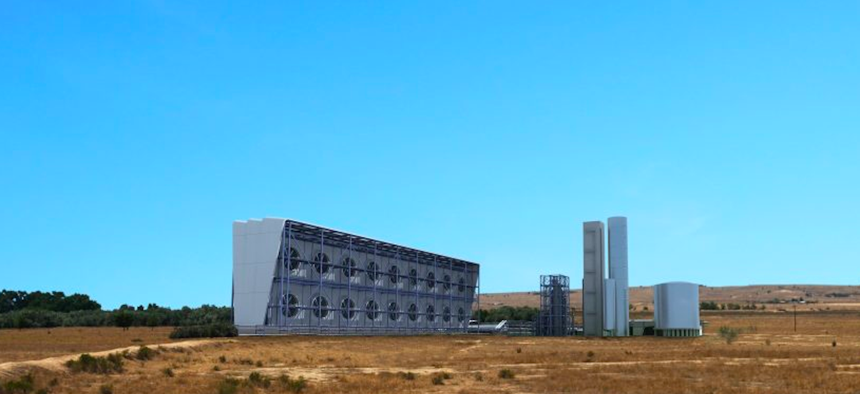
Carbon Engineering's pilot carbon removal facility in Squamish, Canada. The company sells technology that removes carbon from the air and produces fuel. Carbon Engineering
House Defense Bill Would Mandate Carbon Capture Program for the Military
A technology that many hope will prevent the worst effects of climate change could also produce fuel or other defense products.
Efforts to suck greenhouse gases from the atmosphere would get a boost from the House version of the 2020 defense authorization bill, which requires the Defense Department and other federal agencies to create a program to turn carbon in the air and seas into fuel or other products of military use.
Dubbed the Direct Air Capture and Blue Carbon Removal Technology Program, the effort would seek to “develop and demonstrate technologies that capture carbon dioxide from seawater and the air to reuse such carbon dioxide to create products for military uses.”
Small-scale carbon capture has existed for decades as part of industrial processes and as a means to boost fuel production. In 1999, researchers at Los Alamos National Lab proposed to scale up the technology to help reduce global carbon pollution and thus slow climate change. Initially, progress was slow. In 2003, the cost of extracting from the atmosphere one ton of carbon — about the amount produced by burning 100 gallons of gasoline — was more than $600. But technology is changing the calculation every day as new practices come on board to reduce the cost of capture and to actually do something with the captured carbon.
There’s still a lot of math to work out, but sequestered carbon can be used to make fuel, which offsets (but does not surpass) the cost of capturing it. David Keith, founder of a company called Carbon Engineering, last year published a commercialized breakdown of the costs of conversation using modern methods in the academic journal, Joule.
The company already has a pilot plant in Squamish, British Columbia, that is converting carbon to fuel. The output, right now, is more expensive than a typical barrel of oil but in places that have a carbon tax, the fuel can be cheaper, depending on the tax. Keith has said that with more customers they’ll be able to scale up production and the costs would descend further.
Of course, measuring the benefits of carbon adaptation defies conventional economic practice, since the investments have to be made individually but the benefits are shared. There are, however, very real benefits in terms of avoiding the worst effects of climate change. An August study from the National Bureau of Economic Research found that the potential costs of extreme weather, drought, and other calamities resulting from climate change could begin to cost the U.S. more than 10 percent of its GDP by 2100.
In a June 2018 profile, Keith told National Geographic, “This isn’t going to save the world from the impacts of climate change, but it’s going to be a big step on the path to a low-carbon economy.”
The United States military emits more carbon than any company, and, in fact, more than many industrialized nations, according to a June study from Brown University. If the new program provision of the NDAA makes it into the final law, then the U.S. military could play a big role in speeding that transition.




